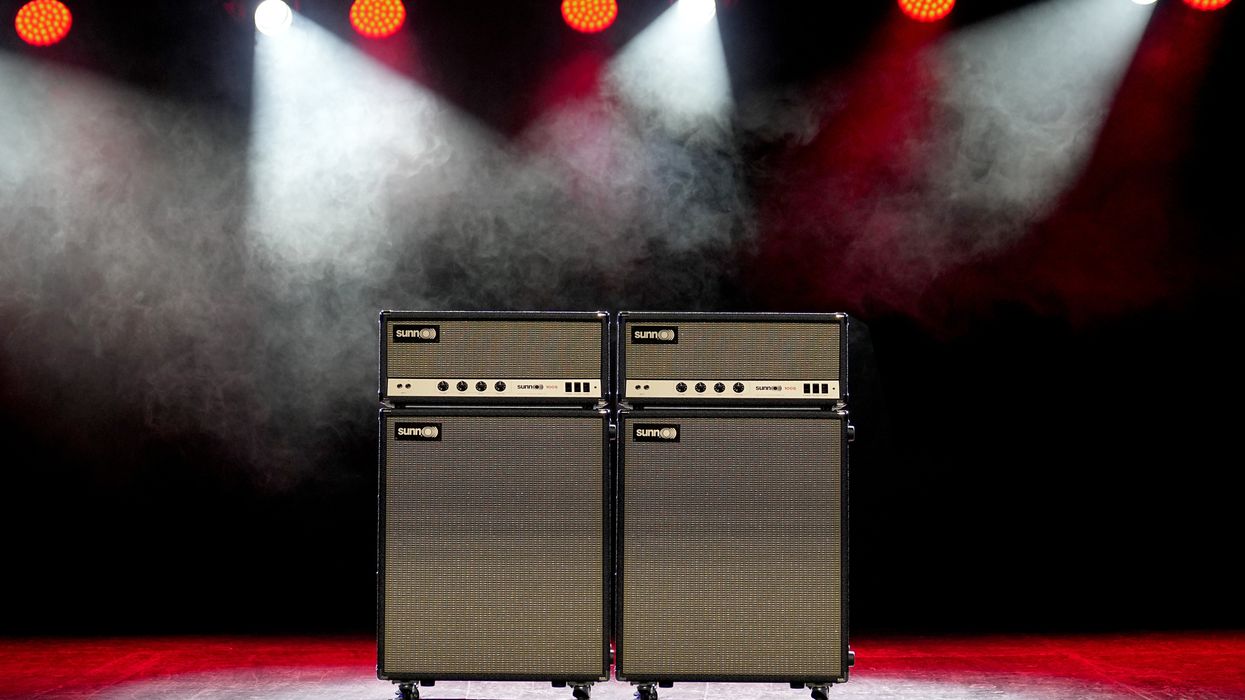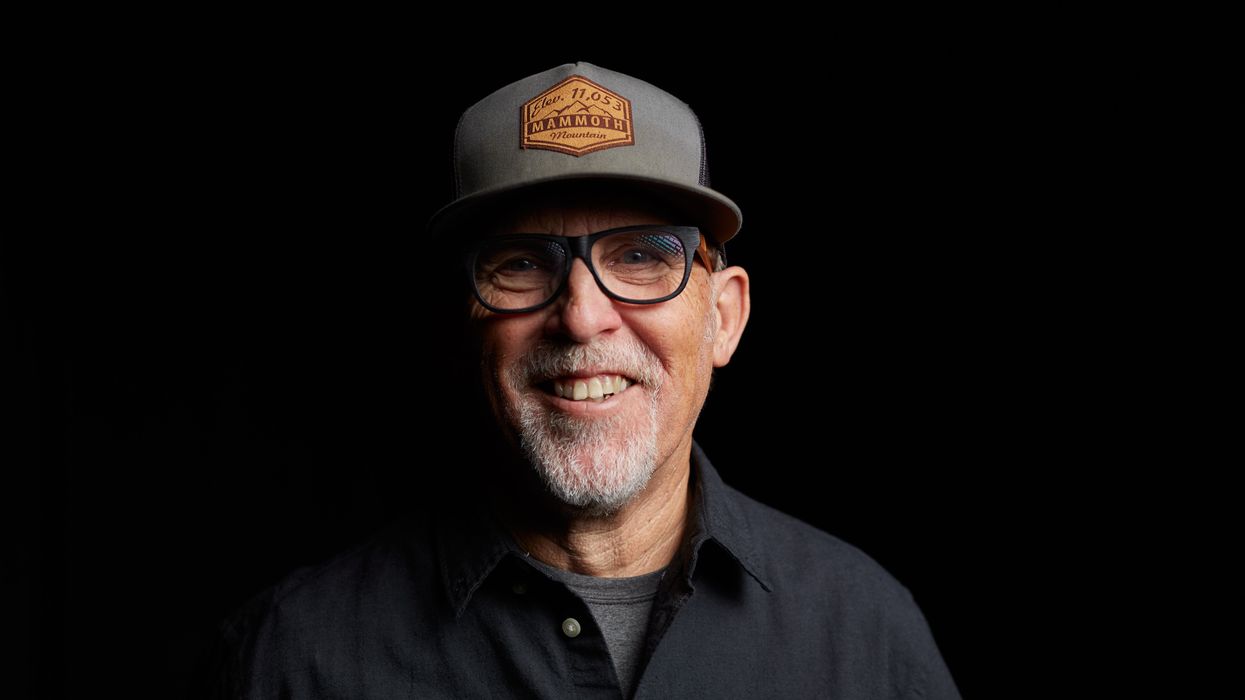“Have you ever considered covering ‘Louie Louie,’” I ask Stephen O’Malley over Zoom. The doom-metal guitarist and half of the band Sunn O))) is a native of Seattle but has lived the past 20 years in Paris, France. “I see where you’re going with this,” O'Malley chuckles, and says, “but we’re not a rock ’n’ roll band. Still, the Kingsmen and Conrad Sundholm building a bass amp for his brother—that’s a legendary Northwest story.”
In 1963, the Portland, Oregon-based Kingsmen found themselves near the very top of the charts behind what would become a garage-rock standard, the immortal “Louie Louie.” The Kingsmen’s bass player, Norman “Norm” Sundholm, and his brother, Conrad Sundholm, simultaneously became seminal figures in developing an amplifier line that would eventually become the sonic foundation of the doom-metal music artists like Stephen O’Malley play. In between, the amps became a crucial sound in classic rock.
The Kingsmen’s version of “Louie Louie” [written by Richard Berry] sat in the Billboard Hot 100 chart for 18 weeks, peaking at number two. Suddenly, everyone wanted to see the band live, and they hit the road, playing on stages all over the country. PA systems geared toward high fidelity for rock ’n’ roll concerts were still several years away, and Norm Sundholm needed a bass amp that could stand up to the rigors of the road and be loud and clear enough for the concert halls and gymnasiums hosting the Kingsmen.
Norm’s brother, Conrad, was a high school physics teacher and an electronics wizard. The siblings rolled up their sleeves together to build a bass amp for the Kingsmen’s first big tour. According to an interview Norm gave to NAMM in 2019, they first modified a 26-watt Fender Bandmaster, replacing the speakers with JBLs and adding a preamp stage using an off-the-shelf amplifier manufactured by Dynaco. Using their surname as inspiration, they called the 60-watt amp a Sunn.
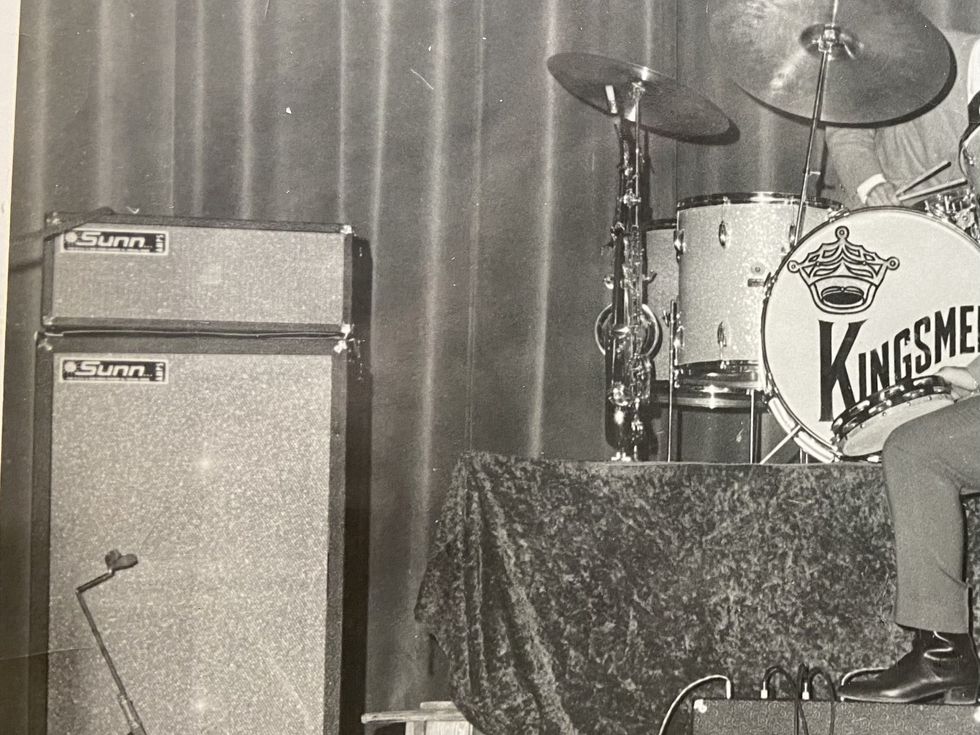
Hot on the heels of their hit single “Louie Louie,” the Kingsmen needed more amp power. Bassist Norm Sundholm turned to his brother Conrad, who started the Sunn brand with this early model.
Photo from the collection of Bill Eberline
Norm Sundholm declined to be interviewed for this piece, and Conrad Sundholm died in 2021, but his son, Steve Sundholm, fills in what came next: “Uncle Norm gave out my dad’s number to fans at Kingsmen shows who heard this amp and wanted to buy one. So my dad started getting random calls from people around the country asking how they could purchase a Sunn amp.” By about 1965, Conrad borrowed $1,300 from his credit union to begin building speaker cabinets and cobbling together new Sunn amps. Partly using Dynaco components and employing JBL speakers, early models included the 100S for guitar and the 200S for bass. Throughout 1963 and 1964, Conrad Sundholm built Sunn amps in his garage.
During downtime from Kingsmen tours, Norm went on the road in search of retailers to carry the Sunn line. While on tour, he met Bill Eberline, an 18-year-old disc jockey from Michigan, and hired him to be the company’s first sales rep. Eberline worked in 18 states east of the Mississippi, setting up retailers. Now 79 years old, Eberline tells me, “For me, Sunn was a passion, and the reason it was a passion was because the amps and the cabinets were so good. I loved the look on a musician's face when they plugged in for the first time and turned it up.” The secret, he says, was not only the amplifiers’ power and tone, but also the unique design of the speaker cabinets.
“The speaker cabinets for our bass amp, the 200S, were called rear-loaded, folded-horn, bass-reflex enclosures,” he explains. “So the speaker comes in from the back, there’s baffling inside, and the speaker is tuned to the cabinet. So you get the most out of it; you’re getting as much sound off the back as you’re getting off the front. I used to demonstrate it to people using a match. I’d put a lit match in front of the speaker, and it would blow the match out. Other speakers had open backs, so you were losing all that sound. And it gave it an incredible punch. It was the best bass speaker cabinet, at the time, that had ever been built.”
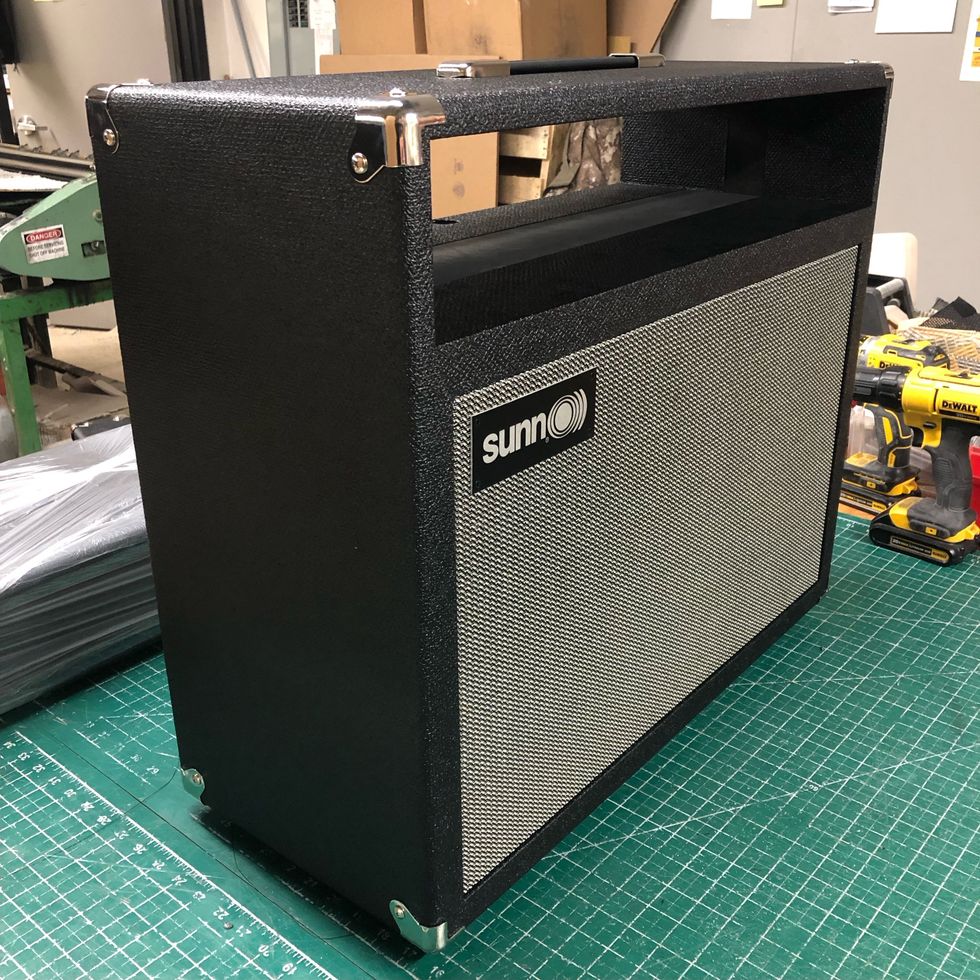
After sitting dormant for more than two decades, the Sunn brand has been resurrected by a new team that promises to stick to the company’s core construction techniques while addressing the needs of modern players. This cab is classic Sunn.
“We started going from music store to music store, unloaded them out of the van, and wheeled them into shops,” Norm Sundholm told NAMM. “It was a little tough with the franchise Fender dealers, but any competing store was wide open to take the line.”
It was Bill Eberline who brought one of Sunn’s biggest retailers to the party: Manny’s Music in New York City. Manny’s was the epicenter of Manhattan’s music retailers row on West 48th Street. About 10 different shops lined the block between 6th and 7th Avenues, making it simple to stumble from one to another. From Jimi Hendrix to Jimmy Page, all the premier guitarists of the day shopped there.
“I used to demonstrate it to people using a match. I’d put a lit match in front of the speaker, and it would blow the match out.” —Bill Eberline
“At first, Manny’s wasn’t interested,” Eberline recalls. “And Manny himself eventually kicked me out of the store; I was hanging out there all day with this big amplifier. But as I was leaving, one of his competitors across the street saw me and the amp, and he called me over. He said to me, ‘Listen, kid. [Eberline was 20 years old at the time.] Have your factory ship me a bunch of empty boxes with the Sunn logo.’ And I did! He put these out on the street in front of his shop like they were trash, as if he had ordered a bunch of our amps.” Soon after seeing the boxes, Manny’s placed an $80,000 order. That huge sale, in 1965, gave Sunn enough capital to move into a bigger manufacturing space, which Steve Sundholm tells me was his grandfather’s garage. “It was big, like the size of a boathouse,” he says.
Inside the garage, Sunn built tube guitar and bass amps such as the 60-watt 100S and 200S, and the 120-watt 1000S and 2000S, as well as the solid-state 100-watt Beta series and the 300-watt (at 2 ohms) Coliseum. The amps quickly became known for their volume, punch, and ability to deliver an articulate bottom end, and they became increasingly more visible on high-profile stages. Noel Redding, playing bass in the Jimi Hendrix Experience, used six Sunn speaker cabinets and three amp heads in June 1967 at the Monterey Pop Festival. Sunn amps were also seen and heard in the backlines of Led Zeppelin, the Who, and Cream. Hendrix most likely purchased his Sunn gear at Manny’s Music. Eberline remembers, “Jimi played through two of our most powerful amps daisy-chained together—the 1000S, double the power of the regular [100S] amp, and it used four KT88 tubes. He put that through four Sunn cabinets with two 15-inch speakers in each cab.”
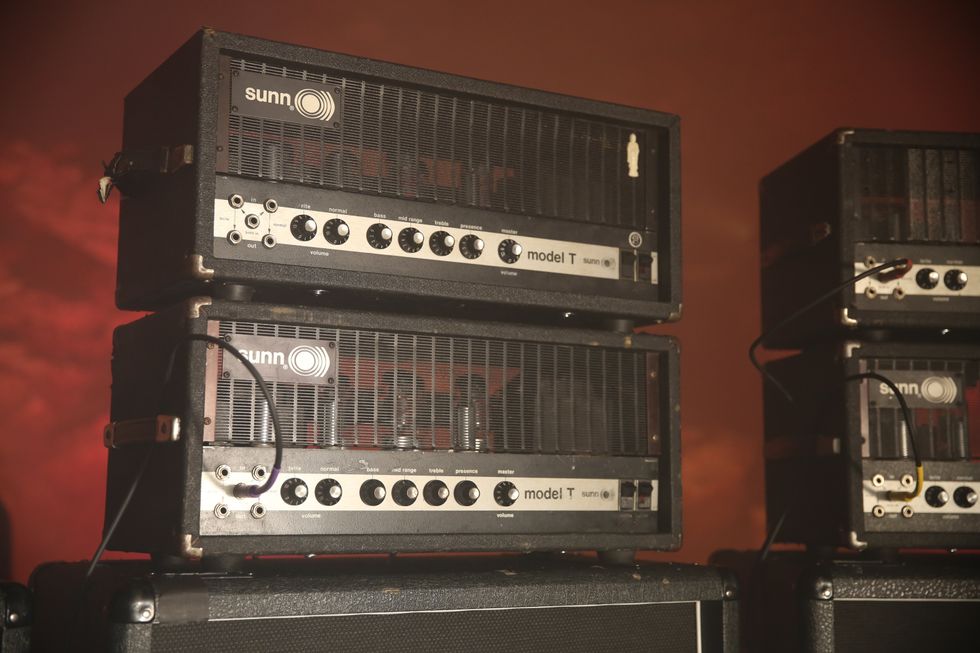
The Model T, one of the most coveted amps to bear the Sunn name, was created during Tom Hartzell’s ownership of the company. This is one of the many employed by Sunn O))) guitarists Stephen O’Malley and Greg Anderson.
Photo by Chris Kies
In August 1969, Eberline trucked Sunn amps to Woodstock, where they appeared behind Felix Pappalardi and Leslie West of Mountain on their Saturday evening set. That got Eberline into trouble. The roadies at Woodstock kept all the loaned amps, Sunn lost the inventory, and Eberline was fired.
James Lebihan is the CEO of the newly relaunched Sunn brand. He takes the history further, telling me over Zoom, “Everybody used Sunn gear—the Beach Boys, the Allman Brothers, and the Jeff Beck Group. Even later, bands like Queen used Sunn amps.” The Rolling Stones considered endorsing Sunn amps. However, according to the book Rolling Stones Gear by Andy Babiuk and Greg Prevost, the Stones’ shipment of amps was damaged in transit, and the endorsement never materialized.
The common denominator for the bands embracing Sunn was the desire for an overdriven tone with a lot of bottom end. In other words, the sound was heavy. Their tone was perfect for early metal and hard-rock artists like Black Sabbath and Mountain. West used a Sunn speaker cabinet to record their iconic “Mississippi Queen” at the Record Plant in New York City.
In 1972, a few years after leaving their dad’s boathouse-size garage and opening a factory in Tualatin, Oregon, the Sundholm brothers sold their company to a manufacturer named Tom Hartzell. Although a few of Sunn’s best models emerged during that period—including the iconic, tube-driven, 150-watt Model T—the Hartzell years are considered by many to be somewhat lost. Eberline says, “I left before they sold the company, but those new guys did not know what they were doing, in my opinion.” Hartzell was not a music-business guy and didn’t quite grasp the industry’s economics. Then, in 1977, he perished in a plane crash.
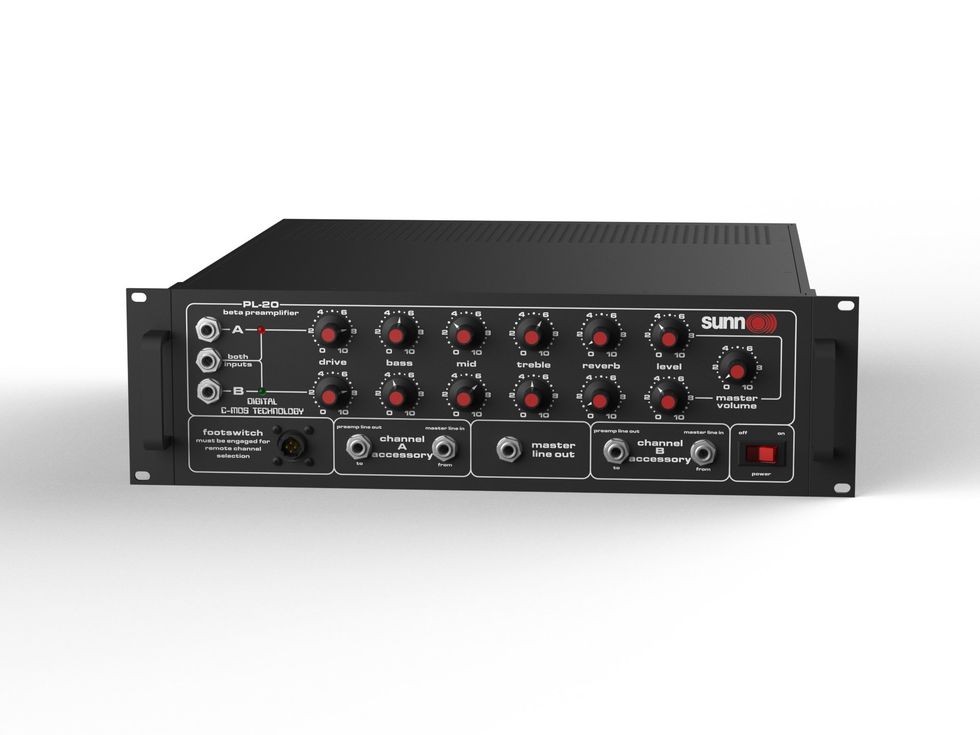
The magic of the Sunn Beta Lead and Bass amps was in their preamps. Here’s a current rackmount-ready version of that famed preamp unit, from the new Sunn factory.
Not much happened after Hartzell’s passing, and the brand lay dormant until Fender purchased Sunn in 1985, just as punk rock and metal split into genres, including hardcore, doom metal, and grunge. Sunn amps were embraced by guitarists like the Melvins’ Buzz Osborne and Nirvana’s Kurt Cobain. That’s when Stephen O’Malley first became aware of them. “I was into hardcore and death metal,” he remembers. “I was15 years old, and I saw the Melvins. They burst my brain open. Joe Preston is on bass, and Buzz Osborne is playing two full Sunn stacks with two Sunn Beta Leads. That was the first time I heard loud guitar where it was ripping the air apart, and you feel it in your body.” O’Malley also recalls seeing Northwest heavy rockers Karp using a Model T, and he praises that amp’s ability to be adapted to a genre like doom metal.
“We modify them,” he explains. “We put in special tubes, and we’re able to change the bias of the amps. We take out what we don’t need, like the line out, and we take out the circuit breaker and replace it with a fuse. The Model T allows me to have less breakup in the preamp section and more headroom. It becomes more about speaker distortion and power-tube overdrive than high-input gain.”
The essential, blue-ribbon quality of the Model T—even unmoded—is how it works with overdrive and fuzz effects. The extraordinary transparency and headroom of these amps allows the sonic character of these pedals to take on enormous, growling dimensions—so they become almost supernatural versions of themselves.
Was it only the tone driving these later Northwest-based bands toward Sunn Amps? Perhaps not. Sunn had long been an Oregon company, so there were a lot of cheap, used Sunn amps sitting around in guitar shops from Portland to Seattle. Lebihan explains it this way, “When these guys were getting started, and they were teenagers, and they were in school, and they didn’t have any money, they could find these Beta Leads and Model Ts in pawn shops.” Stephen O’Malley tells me that his partner in Sunn O))), Greg Anderson, found his first Model T at a swap meet in Seattle—a vinyl dealer left it sitting under a table of records.
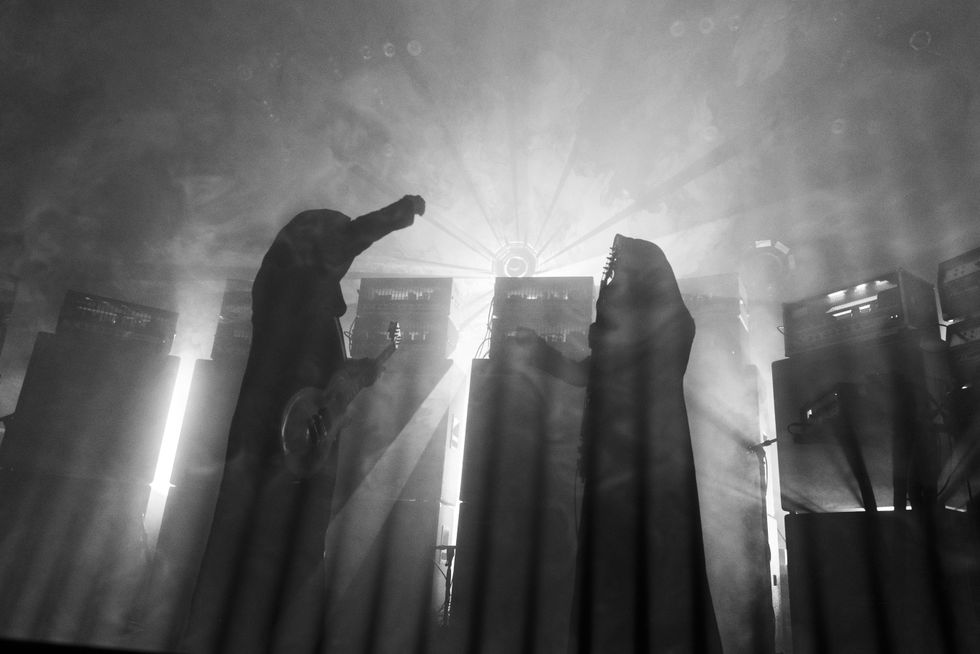
No band has taken the term “amp worship” more literally than Sunn O))), seen here leading service in front of a wall that consists mostly of Sunn amps.
Photo by Mike White
The steep headroom, high-gain, tube-driven 100S, 200S, Model T, and solid-state Beta line of bass and guitar heads are now considered the pinnacle of the original line. O’Malley claims some amount of credit for this: “They’re a mythical amplifier now, but I don’t know if they would be if it weren’t for our band and the scene around our band—like Wino Weinrich from the Obsessed, he played them, too.”
“I was 15 years old, and I saw the Melvins. They burst my brain open…. Buzz Osbourne is playing two full Sunn stacks with two Sunn Beta leads. That was the first time I heard loud guitar where it was ripping the air apart, and you feel it in your body.” —Stephen O’Malley
Until recently, Fender’s ownership would not be considered a new golden age for Sunn; not much happened. Fender did drop a Model T reissue, but that amp shared virtually none of the same circuitry as its Hartzell-era predecessor. Strangely, Fender actually built some electric guitars—using the Mustang and Strat names—overseas under the Sunn brand. But overall, the brand languished, making the vintage gear rare and sought-after in the used market.
Lebihan tells me that many have tried to get Fender to relaunch Sunn since the brand was discontinued in 2002. Still, it was only when he came to the table in 2023 and brought Mike Eldred and Steve Skillings with him that Fender executives finally sat up in their chairs and made a deal to relaunch Sunn. This triumvirate brings decades of musical marketing skills to the party: Lebihan had a background in tech before becoming a serial entrepreneur in the music world; Eldred was on the team that put the Fender Custom Shop on the map in the mid ’90s; and Skillings came from a background at Bose, where, among other things, he was on the Bose L1 team—the group that created the ubiquitous skinny-speaker PA systems popular with buskers, garage jammers, and wedding bands.
Together, this team has big plans for Sunn, and early on they ran a Wefunder campaign in which 288 enthusiasts were able to support the new Sunn company in exchange for discounts on amps and branded swag like t-shirts and pint glasses. The cash, says Skillings, is fueling costs for tooling and other early manufacturing requirements. “There’s a lot of costs associated with ramping up this kind of product,” he notes. “Just to do a mold for a knob, for example, costs $5,000.”
“There are cheaper ways to manufacture these things that would make it ‘not Sunn.’ And I see them going out of their way to recreate it as faithfully as possible without making it the cost of a mortgage payment to the customer.” —Steve Sundholm
And they’re preparing to drop new generations of amps in the near future. Not only will Sunn’s popular tube amps be back, but they’re also creating solid-state bass heads and new cabinets. And they plan to push well beyond what Sunn has been known for for 60 years. Mike Eldred is visibly excited when he says, “We’ve got a Beta combo amp coming up for preorder very soon. And we’re going to continue pushing into the combo market and beyond. You have a lot of folks now who don’t want to lug around a heavy 150-watt amp and products are coming out now that reflect that, where your amp is on your pedalboard. We’re going to go after that market aggressively.”
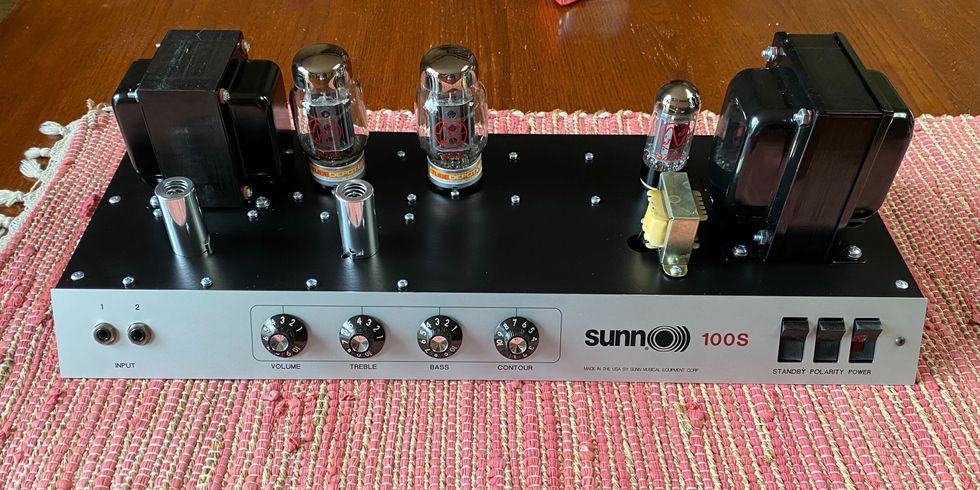
The essence of the modern Sunn 100S.
One thing everyone is curious about is the future of the Model T, the amp most heavily embraced by O’Malley, Anderson, and other doom-metal axe grinders. That’s something the new Sunn team is rethinking very carefully. The Model T offers a singular tone, but in today’s live music environment, where portability and low-wattage amps rule, it’s a bit of a dinosaur. Eldred says, “There’s no reason why you can’t take the tone stack of a Model T and pare it down into something like a 20-watt version of the amp.”
Steve Sundholm became a board member of the new Sunn brand after his dad passed away. He tells me that at the end of his dad’s life, Conrad knew Sunn was coming back. “He told me, ‘Man, I hope they do it right.’ Not ‘They better do it right,’ just ‘I hope they do.’” Steve is convinced that his dad would be proud of this relaunch. “I’ve seen their plans,” he says, “and I really feel like they are going above and beyond to do it right. For example, they’re building the same closed-back cabinet style as the vintage speakers. There are cheaper ways to manufacture these things that would make it ‘not Sunn.’ And I see them going out of their way to recreate it as faithfully as possible without making it the cost of a mortgage payment to the customer.”
O’Malley, who considers the amps in his backline “members” of his group, also looks forward to checking out the upcoming line and what the new Sunn team is doing. He says, “I understand that they are building the new amps to original specs; I’m really curious about them.” Even still, a “Louie Louie” cover from Sunn O))) to connect the dots probably won’t materialize.
There’s no doom-metal band out there I can find who’s covered the Kingsmen’s signature tune, although both Motörhead and Black Flag have taken great, heavy shots at it. Perhaps they may have even used Sunn amps in the process. As Sunn rises again, illuminating the musical landscape once more, the chance for new riffs and powerful sounds to come from this brand is brighter than ever.
